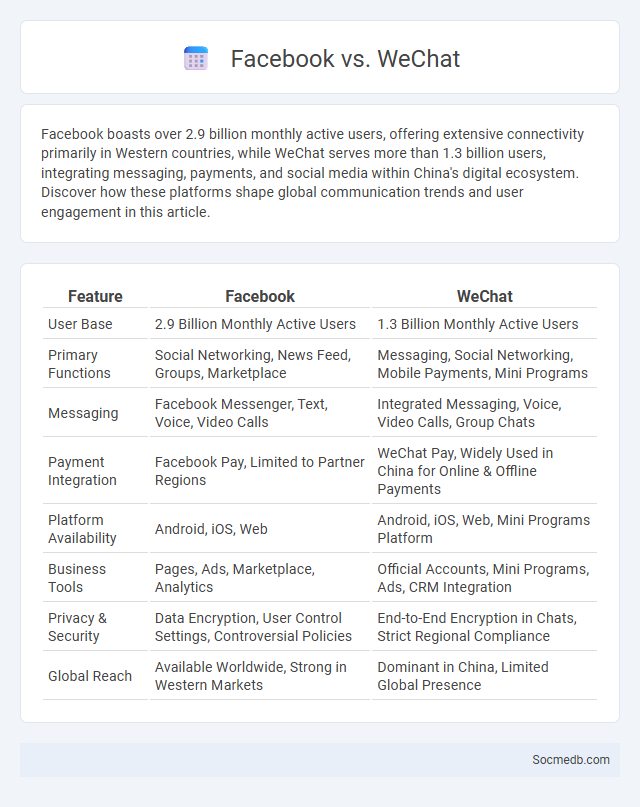
Photo illustration: Facebook vs WeChat
Facebook boasts over 2.9 billion monthly active users, offering extensive connectivity primarily in Western countries, while WeChat serves more than 1.3 billion users, integrating messaging, payments, and social media within China's digital ecosystem. Discover how these platforms shape global communication trends and user engagement in this article.
Table of Comparison
| Feature | ||
|---|---|---|
| User Base | 2.9 Billion Monthly Active Users | 1.3 Billion Monthly Active Users |
| Primary Functions | Social Networking, News Feed, Groups, Marketplace | Messaging, Social Networking, Mobile Payments, Mini Programs |
| Messaging | Facebook Messenger, Text, Voice, Video Calls | Integrated Messaging, Voice, Video Calls, Group Chats |
| Payment Integration | Facebook Pay, Limited to Partner Regions | WeChat Pay, Widely Used in China for Online & Offline Payments |
| Platform Availability | Android, iOS, Web | Android, iOS, Web, Mini Programs Platform |
| Business Tools | Pages, Ads, Marketplace, Analytics | Official Accounts, Mini Programs, Ads, CRM Integration |
| Privacy & Security | Data Encryption, User Control Settings, Controversial Policies | End-to-End Encryption in Chats, Strict Regional Compliance |
| Global Reach | Available Worldwide, Strong in Western Markets | Dominant in China, Limited Global Presence |
Introduction to Facebook, WeChat, and Digital Footprint
Facebook remains one of the largest social media platforms globally, connecting billions through its user-friendly interface and diverse features like groups, pages, and marketplace. WeChat integrates messaging, social networking, and payment services, making it essential for digital communication and lifestyle management, especially in China. Understanding your digital footprint on these platforms is crucial for managing privacy, personal branding, and online reputation.
Key Features Comparison: Facebook vs WeChat
Facebook offers extensive social networking features such as news feeds, groups, events, and marketplace, while WeChat integrates messaging, social media, and mobile payment services in one app. You benefit from Facebook's global reach and rich media sharing capabilities, whereas WeChat excels in seamless communication and e-commerce within the Chinese market. Both platforms support multimedia content, but WeChat's mini-programs and QR code integration provide distinct advantages for everyday digital transactions.
User Demographics and Global Reach
Social media platforms attract diverse user demographics spanning age, gender, income, and interests, enabling tailored content and advertising strategies. Understanding these demographics helps you target the right audience effectively, maximizing engagement and conversions. The global reach of social media connects billions of users across continents, making it a powerful tool for international brand awareness and communication.
Privacy Settings: Control and Limitations
Social media platforms offer privacy settings that allow users to control who can view their content, share personal information, and interact with their profiles, enhancing online security. These settings include options to limit profile visibility, restrict friend requests, and manage data sharing with third-party applications. Understanding and regularly updating privacy controls is essential to protect personal data and prevent unauthorized access.
Messaging and Communication Differences
Social media platforms vary widely in messaging and communication styles, with instant messaging apps like WhatsApp and Telegram emphasizing real-time, encrypted conversations, whereas platforms like Facebook and LinkedIn integrate asynchronous messaging with content sharing and professional networking. The choice of platform often depends on user intent, ranging from casual chats and multimedia sharing on Instagram and Snapchat to more formal, text-based communications on Twitter. Understanding these differences is crucial for effective digital interaction, marketing strategies, and privacy management across diverse social networks.
Data Collection Practices
Social media platforms collect vast amounts of user data, including personal information, browsing habits, and interaction patterns, to tailor content and advertisements effectively. Advanced algorithms analyze this data to create detailed profiles, enabling targeted marketing and influencing user behavior. Privacy concerns arise as users often lack transparency and control over how their data is collected, stored, and shared with third parties.
Digital Footprint: What Users Leave Behind
Users leave behind a digital footprint consisting of data traces such as posts, comments, location check-ins, and browsing behavior on social media platforms. This information can be analyzed by algorithms to tailor advertisements, influence online reputation, and impact privacy settings. Understanding the extent and permanence of digital footprints is crucial for managing online presence and safeguarding personal information.
Security Measures and Risks
Protecting Your social media accounts requires robust security measures such as two-factor authentication, strong passwords, and regular privacy settings reviews. Risks like phishing attacks, data breaches, and unauthorized access threaten your personal information and online reputation. Staying vigilant and updating security protocols minimizes exposure to cyber threats on social platforms.
Social Impact and Cultural Influence
Social media shapes cultural narratives by amplifying diverse voices and fostering global connectivity that transcends geographical boundaries. Your engagement on these platforms contributes to social movements, raising awareness and driving change in issues such as equality, environmentalism, and human rights. This dynamic interaction promotes inclusivity and redefines cultural norms in real-time.
Choosing the Right Platform: Implications for Your Digital Footprint
Selecting the ideal social media platform shapes your digital footprint by determining the audience, content type, and engagement style that best aligns with your personal or professional goals. Each platform, from Instagram's visual-centric approach to LinkedIn's professional networking, offers unique tools and algorithms that influence visibility and interaction. Understanding these differences helps you optimize your online presence and ensures your digital identity reflects your desired influence and reach.
 socmedb.com
socmedb.com